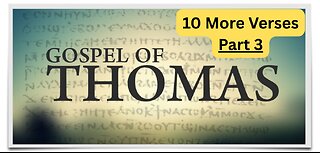Premium Only Content

Who Was Judas According to the Gnostic Gospels?
Judas Iscariot according to the Gnostic Gospels: An Enlightened
Disciple, Not a Traitor
Judas Iscariot, infamous in traditional Christian accounts as the betrayer of Jesus, is portrayed in a dramatically different light in the Gnostic Gospels, particularly the Gospel of Judas. This ancient text, originating from the second century and written in Coptic, presents Judas not as a villain motivated by greed or malice but as Jesus’ most trusted and enlightened disciple entrusted with secret knowledge and a divine mission.
The Gospel of Judas: A Radical Reinterpretation
Discovered in the 1970s and publicly revealed in 2006, the Gospel of Judas reflects Sethian Gnostic theology, which views the material world as corrupt and ruled by a lesser deity known as the Demiurge. According to this gospel, Judas alone understands Jesus’ true divine nature and mission. Jesus reveals to Judas “secrets no other person has ever seen” and instructs him to facilitate the crucifixion, telling him, “You will sacrifice the man that clothes me.” Here, the “man” symbolizes Jesus’ physical body, and Judas’ role is essential to freeing Jesus’ divine spirit from the confines of the material world.
Key Gnostic Themes in Judas’ Portrayal
Spiritual Dualism: Gnosticism contrasts the flawed, material universe with the transcendent, spiritual realm. Jesus’ death is not portrayed as a tragedy but as a necessary step toward liberation from physical existence.
The Demiurge and False God: The God worshiped by many of Jesus’ other disciples is depicted as Yaldabaoth, a blind and ignorant creator of the material world. Judas, by contrast, aligns with the higher, unknowable God beyond this flawed creation.
Secret Knowledge (Gnosis): Salvation comes through esoteric revelation. Judas alone receives this gnosis from Jesus, emphasizing his unique role and spiritual enlightenment.
Critique of Other Disciples: The other apostles are portrayed as spiritually blind and followers of the Demiurge, unable to grasp Jesus’ true message.
Judas as the Obedient Servant and Martyr
Far from being a betrayer, Judas is cast as a figure who, burdened with a difficult task, obeys Jesus’ command to hand him over, thus becoming a necessary agent in the divine cosmic plan. This reinterpretation challenges orthodox Christian views that cast Judas as the symbol of treachery and sin. Instead, Judas is considered a martyr of truth and loyalty, misunderstood and vilified by history.
Historical and Theological Context
The Gospel of Judas belongs to a broader body of Gnostic texts that flourished in the 2nd and 3rd centuries CE, presenting alternative interpretations of Jesus and his disciples. Such texts were deemed heretical by proto-orthodox Christianity and largely suppressed. The orthodox narrative of Judas as a betrayer serving satanic motives prevailed, solidifying his negative legacy.
Legacy and Modern Impact
The rediscovery of the Gospel of Judas offers a profound window into the diversity of early Christian thought, highlighting theological debates about the nature of Jesus’ mission, salvation, and betrayal. It invites readers to reconsider the meanings of loyalty, sacrifice, and divine purpose beyond traditional boundaries.
Conclusion
In the Gnostic worldview, Judas Iscariot emerges not as a villain but as the enlightened confidant of Jesus, who carries out a necessary and divinely ordained mission to free Jesus' spirit from its material captivity. This portrayal invites reflection on how religious narratives are shaped and challenges long-held assumptions about betrayal and salvation, illuminating the rich, complex tapestry of early Christian history and theology
-
 6:43
6:43
Doubting Tomasz 2.0
1 day ago10 verses from the Gnostic Gospel of Thomas Part 3
33 -
 14:05
14:05
Sideserf Cake Studio
18 hours ago $12.87 earnedHYPERREALISTIC HAND CAKE GLOW-UP (Old vs. New) 💅
48.3K7 -
 28:37
28:37
marcushouse
20 hours ago $6.97 earnedSpaceX Just Dropped the Biggest Starship Lander Update in Years! 🤯
21.7K6 -
 14:54
14:54
The Kevin Trudeau Show Limitless
3 days agoThe Hidden Force Running Your Life
100K21 -
 2:16:35
2:16:35
DLDAfterDark
7 hours ago $5.80 earnedIs The "SnapPocalypse" A Real Concern? Are You Prepared For SHTF? What Are Some Considerations?
21.9K9 -
 19:58
19:58
TampaAerialMedia
18 hours ago $7.80 earnedKEY LARGO - Florida Keys Part 1 - Snorkeling, Restaurants,
36.7K17 -
 1:23
1:23
Memology 101
2 days ago $7.07 earnedFar-left ghoul wants conservatives DEAD, warns Dems to get on board or THEY ARE NEXT
29.9K59 -
 3:27:27
3:27:27
SavageJayGatsby
9 hours ago🔥🌶️ Spicy Saturday – BITE Edition! 🌶️🔥
56.8K6 -
 26:09
26:09
Exploring With Nug
18 hours ago $12.27 earned13 Cold Cases in New Orleans What We Discovered Beneath the Surface!
53K23 -
 27:39
27:39
MYLUNCHBREAK CHANNEL PAGE
13 hours agoDestroying Time.
135K41